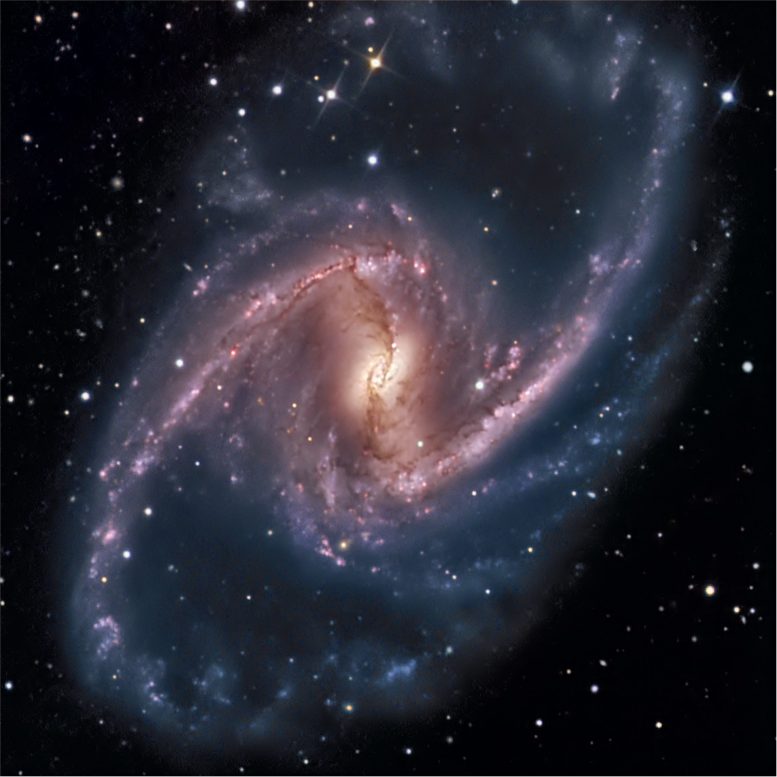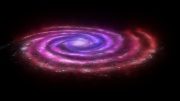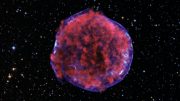
An image of the galaxy NGC 1365, whose nucleus contains a massive black hole actively accreting material. Astronomers have used a series of X-ray observations to measure time variations in the iron emission line from the nucleus and thereby determine the value of the black hole’s spin. Credit: SSRO-South (R. Gilbert, D. Goldman, J. Harvey, D. Verschatse) – PROMPT (D. Reichart)
Using observations from NuSTAR and XMM-NEWTON, a team of astronomers examined the time-varying spectral shape of highly excited iron atoms in the nucleus of the galaxy NGC 1365.
The nuclei of most galaxies contain a massive black hole. In our Milky Way, for example, the nuclear black hole contains about four million solar masses of material, and in other galaxies the black holes are estimated to have masses of hundreds of millions of suns, or even more. In dramatic cases, like quasars, these black holes are suspected of driving the observed bipolar jets of particles outward at nearly the speed of light. How they do this is not known, but scientists think that the spin of the black hole somehow plays a pivotal role.
A black hole is so simple (at least in traditional theories) that it can be completely described by just three parameters: its mass, its spin, and its electric charge. Even though it may have formed out of a complex mix of matter and energy, all the other specific details are lost when it collapses to a singular point. Astronomers are working to measure the spins of black holes in active galaxies in order to probe the connections between spin and jet properties.
One method for measuring black hole spin is X-ray spectra, by looking for distortions in the atomic emission line shapes from the very hot gas in the accreting disk of material around the black hole. Effects due to relativity in these extreme environments can broaden and skew intrinsically narrow emission lines into characteristic profiles that depend on the black hole spin value.
CfA astronomers Guido Risaliti, Laura Brenneman, and Martin Elvis, together with their colleagues, used joint observations from the NuSTAR and XMM-NEWTON space missions to examine the time-varying spectral shape of highly excited iron atoms in the nucleus of the galaxy NGC 1365, a well-studied active galaxy about sixty-six million light-years away and known for exhibiting time-variable line profiles. The team obtained four high quality observations of the source, catching it over an unprecedented range of absorption states, including one with very little line-of-sight absorption to the central nucleus. All the observations, despite the range of absorptions, displayed hallmarks of the innermost regions of the accretion flow. There have been disagreements within the community about the reliability of attributing observed line shapes to the black hole spin (rather than to other effects in the nucleus), but this new result not only demonstrates that it is possible, it shows that even single-epoch observations are likely to provide reliable measurements, making the task of studying other such systems more efficient.
Reference: “NuSTAR and XMM-Newton Observations of NGC 1365: Extreme Absorption Variability and a Constant Inner Accretion Disk” by D. J. Walton, G. Risaliti, F. A. Harrison, A. C. Fabian, J. M. Miller, P. Arevalo, D. R. Ballantyne, S. E. Boggs, L. W. Brenneman, F. E. Christensen, W. W. Craig, M. Elvis, F. Fuerst, P. Gandhi, B. W. Grefenstette, C. J. Hailey, E. Kara, B. Luo, K. K. Madsen, A. Marinucci, G. Matt, M. L. Parker, C. S. Reynolds, E. Rivers, R. R. Ross, D. Stern and W. W. Zhang, 23 May 2014, The Astrophysical Journal.
DOI: 10.1088/0004-637X/788/1/76
arXiv: 1404.5620









Be the first to comment on "Astronomers Measure Black Hole Spin in the Nucleus of the Galaxy NGC 1365"